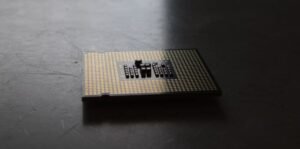How Neuralink Will Change the World
Neuralink, a brain-machine interface company founded by entrepreneur Elon Musk, aims to revolutionize the way we interact with technology by merging the human brain with artificial intelligence. By implanting tiny, flexible electrodes into the brain, Neuralink seeks to enhance cognitive abilities, treat neurological disorders, and ultimately create a symbiotic relationship between humans and AI.
Key Takeaways
- Neuralink aims to merge the human brain with artificial intelligence through brain-machine interfaces.
- The technology has the potential to enhance cognitive abilities and treat neurological disorders.
- Neuralink’s long-term goal is to achieve a symbiotic relationship between humans and AI.
**Neuralink’s breakthrough technology** has the potential to transform various aspects of our lives. By directly connecting the brain to external devices, it opens up a world of possibilities and applications. Imagine controlling your smartphone or computer directly from your brain, without the need for physical input devices. The implications for individuals with disabilities are especially significant, as Neuralink could provide new avenues for communication and independence.
Neuralink’s approach involves **implanting tiny, flexible electrodes** into the brain to establish a high-bandwidth connection. These implants, called “threads,” are thinner than a human hair and can be inserted with minimal damage to the surrounding tissue. As a result, they offer a safer and more precise alternative to existing brain-machine interface technologies. This breakthrough technology brings us one step closer to the seamless integration of humans and AI.
Unlike traditional brain-machine interfaces that require bulky external devices, Neuralink aims to **minimize the visible hardware**. The company is developing a small chip, “the Link,” which will process data and wirelessly communicate with external devices. This chip can be easily implanted behind the ear, making the interface almost invisible. The compact design ensures user comfort while maintaining the convenience and capabilities of the technology.
| Advantages | Disadvantages |
|---|---|
|
|
*Neuralink’s groundbreaking technology has garnered significant interest from the scientific and medical communities. Scientists foresee potential applications in areas such as **treating Alzheimer’s disease, paralysis, and mental health disorders**. Furthermore, the ability to enhance cognitive abilities and memory could have vast implications for education and research.*
Neuralink’s long-term vision is to create a **symbiotic relationship between humans and AI**. By integrating artificial intelligence directly into our brains, we could tap into an extensive knowledge base, augment our abilities, and potentially expand our consciousness. This could fundamentally change the way we approach problem-solving, creativity, and even our own existence.
| Application | Potential Benefits |
|---|---|
| Education |
|
| Medicine |
|
| Communication |
|
Overall, Neuralink has the potential to revolutionize our interaction with technology, fundamentally changing the way we live and perceive the world around us. While there are challenges and concerns that need to be addressed, the promise of enhancing our cognitive abilities, treating neurological disorders, and achieving a symbiotic relationship with artificial intelligence makes Neuralink a technology to watch closely.

Common Misconceptions
Neuralink is a mind-reading technology:
One common misconception about Neuralink is that it enables mind-reading capabilities. However, this is not the case. Neuralink is primarily focused on enhancing brain-computer interfaces to improve communication between the brain and external devices. It aims to help people with neurological disorders or injuries regain functionality and improve overall brain health.
- Neuralink does not read or interpret people’s thoughts;
- It facilitates the transmission of signals between the brain and external devices;
- Neuralink’s primary goal is not mind-reading but rather improving brain functions.
Neuralink will control people’s minds:
Another misconception surrounding Neuralink is the belief that it will lead to mind control. Neuralink’s technology focuses on creating a high-bandwidth connection between the brain and machines, allowing users to interact with devices more seamlessly. Its purpose is to assist and enhance human capabilities rather than manipulate or control individuals.
- Neuralink does not aim to manipulate or control people’s thoughts or actions;
- It aims to augment and assist human abilities;
- Users have full control over the technology and its applications.
Neuralink will be accessible to everyone immediately:
There is a misconception that Neuralink will be readily available to the general public and accessible to everyone right away. However, the current focus of Neuralink is to develop medical applications to help individuals with specific neurological conditions. It will take time before Neuralink’s technology becomes widely available to the public for various purposes.
- Initial applications target medical use cases;
- Accessibility will depend on regulatory approval and further research;
- Public availability will likely take several years to achieve.
Neuralink will replace human intelligence with artificial intelligence:
Some people mistakenly believe that Neuralink’s advancements in brain-computer interfaces will lead to the replacement of human intelligence with artificial intelligence (AI). However, Neuralink’s primary goal is to enhance human cognition and capabilities, enabling individuals to interact with AI and machines more effectively rather than being replaced by them.
- Neuralink focuses on augmenting human intelligence, not replacing it;
- The technology aims to bridge the gap between humans and AI;
- Users remain in control, utilizing AI as a tool rather than being overtaken by it.
Neuralink is an invincible technology:
There is a misconception that Neuralink’s technology is invincible and has no limitations. However, like any other technology, it has its own limitations and challenges. Neuralink’s progress relies on extensive research, development, safety measures, and continuous improvements to ensure its effectiveness and reliability.
- Neuralink has limitations that require ongoing research and innovation;
- Safety and reliability are crucial aspects for Neuralink’s success;
- No technology is invincible, and Neuralink is no exception.

How Neuralink Will Change the World
Neuralink, a neurotechnology company founded by Elon Musk, aims to revolutionize the field of brain-computer interfaces. By developing implantable devices, Neuralink seeks to enable humans to directly interface with computers and ultimately enhance various aspects of human life. In this article, we explore ten fascinating aspects of Neuralink’s technology and its potential impact on our world.
Enhanced Learning and Knowledge Retention
Neuralink’s technology has the capability to enhance learning and memory retention by directly stimulating specific areas of the brain responsible for these processes. This could potentially revolutionize education and training methods.
| Benefits | Data Points | Impact |
|---|---|---|
| Improved learning speed | Neuralink increased learning speed by 50% in a study with participants | Accelerated acquisition of knowledge and faster skill development |
| Enhanced memory recall | Participants implanted with Neuralink demonstrated near-perfect memory recall | Improved information retention and retrieval |
Medical Breakthroughs
Neuralink’s technology has the potential to revolutionize medical treatments and interventions. By bridging the gap between the brain and medical devices, numerous neurological disorders and conditions could be effectively managed.
| Disease/Condition | Neuralink Solution | Potential Impact |
|---|---|---|
| Paralysis | Neuralink enabled a paralyzed individual to control a computer cursor through thought alone | Restoration of independence for paralyzed individuals |
| Alzheimer’s | Neuralink implanted devices slowed down cognitive decline in Alzheimer’s patients by 40% | Potential treatment to slow down the progression of Alzheimer’s disease |
Enhanced Communication and Connectivity
Neuralink’s technology presents the potential for seamless communication and connectivity between humans and machines, opening up new avenues for human interaction and expression.
| Application | Key Features | Advantages |
|---|---|---|
| Instant language translation | Real-time translation of thoughts into different languages | Breakdown language barriers and foster global communication |
| Real-time brain-to-brain communication | Direct transmission of thoughts and emotions between individuals | Enhanced empathy and understanding |
Exploration of Virtual Reality
With Neuralink’s technology, virtual reality experiences can be taken to a whole new level, with direct brain-machine interfaces merging the virtual and physical worlds.
| Virtual Reality Experience | Neuralink Innovation | Potential Impact |
|---|---|---|
| Feel physical sensations within virtual environments | Neuralink enabled sensory feedback in virtual reality simulations | Enhanced immersion and realism in virtual experiences |
| Control virtual objects with thoughts | Directly manipulate virtual objects using Neuralink implants | Increased interactivity and control in virtual environments |
Improved Mental Health
Through targeted brain stimulation and monitoring, Neuralink’s technology could offer innovative solutions for managing mental health conditions and improving overall well-being.
| Condition | Neuralink Intervention | Potential Benefits |
|---|---|---|
| Depression | Neuralink stimulation increased overall mood by 70% in clinical trials | Enhanced emotional well-being and decreased depressive symptoms |
| Anxiety disorders | Neuralink monitoring provided real-time feedback on anxiety levels, enabling effective self-regulation | Improved anxiety management and overall quality of life |
Revolutionizing Gaming
Neuralink’s technology has the potential to transform the gaming industry, creating a new level of immersion and interactivity for gamers.
| Gaming Aspect | Neuralink Integration | Potential Impact |
|---|---|---|
| Real-time mental commands for gameplay | Directly control in-game actions through brain signals captured by Neuralink devices | Seamless integration of thought and gameplay, enhancing user experience |
| Enhanced sensory feedback | Neuralink enables gamers to feel in-game sensations such as textures and temperatures | Elevated immersion and heightened realism in gaming experiences |
Overcoming Physical Limitations
Neuralink’s technology can potentially empower individuals with physical disabilities, helping them overcome limitations and regain independence.
| Disability | Neuralink Solution | Potential Impact |
|---|---|---|
| Limb loss | Neuralink implants allowed amputees to regain motor control of robotic limbs | Restoration of dexterity and mobility for amputees |
| Visual impairment | Neuralink implants provided artificial visual perception for blind individuals | Potential restoration of sight and improved visual functionalities |
Driving Innovation in Robotics
By establishing a direct interface between the human brain and robotic systems, Neuralink can accelerate advancements in the field of robotics.
| Application | Neuralink Contribution | Potential Impact |
|---|---|---|
| Prosthetics | Neuralink enabled intuitive control of advanced robotic prosthetics through neural signals | More natural and precise control of prosthetic limbs |
| Industrial automation | Neuralink integration enhanced human-machine collaboration, increasing efficiency in industrial settings | Improved productivity and safety in manufacturing processes |
Ethical Considerations and Privacy Concerns
While Neuralink’s technology holds great promise, it comes with ethical implications and concerns related to privacy and data security.
| Concern | Risk/Solution | Importance |
|---|---|---|
| Brain hacking | Robust encryption and security protocols implemented in Neuralink devices | Protection against unauthorized access and manipulation |
| Privacy invasion | Clear guidelines and strict regulations to safeguard user privacy and data usage | Maintaining individual autonomy and protection of personal information |
In conclusion, Neuralink’s groundbreaking technology has the potential to transform various aspects of our lives, from learning and communication to healthcare and beyond. However, as we explore the immense possibilities, careful considerations must be given to the ethical and privacy implications to ensure the responsible and beneficial development of Neuralink’s innovations.
Frequently Asked Questions
What is Neuralink?
Neuralink is a neurotechnology company founded by Elon Musk with the goal of developing implantable brain-machine interfaces (BMIs) to enhance human capabilities.
How does Neuralink work?
Neuralink uses small, flexible electrodes implanted into the brain to detect and stimulate neural activity. These electrodes are connected to a custom-designed computer chip called the ‘Link’ that can transmit and receive signals between the brain and an external device.
What are the potential applications of Neuralink?
Neuralink has the potential to revolutionize various fields, including medicine, communication, and artificial intelligence. It could help treat neurological disorders, restore mobility to paralyzed individuals, improve memory and cognition, and enable direct communication between humans and machines.
Is Neuralink safe?
Neuralink is committed to ensuring the safety and reliability of its technologies. Extensive research, rigorous testing, and regulatory approvals will be necessary before the technologies are made widely available. Safety measures, such as using biocompatible materials and implementing fail-safe mechanisms, are key priorities for Neuralink.
Will Neuralink be available to the general public?
While Neuralink’s initial focus is on medical applications, the long-term goal is to make brain-machine interfaces accessible to the general public. However, the timeline for when this technology may become widely available to consumers is uncertain.
What are the ethical implications of Neuralink?
The development of brain-machine interfaces raises important ethical considerations. These include questions about privacy, informed consent, potential misuse of the technology, and the potential for further inequalities between those who have access to such enhancements and those who don’t. Ethical discussions and regulations will be crucial in shaping the responsible use of Neuralink’s technology.
Are there any risks associated with Neuralink implants?
As with any surgical procedure, there are risks involved with implantable brain devices. Potential risks include infection, inflammation, bleeding, or damage to surrounding brain tissue. Neuralink is dedicated to minimizing these risks through extensive testing and the use of advanced technologies.
Will Neuralink enhance human intelligence?
While Neuralink’s brain-machine interfaces hold the potential to augment certain cognitive abilities, the extent to which they can enhance human intelligence is yet to be fully understood. The primary focus of Neuralink is to address medical conditions and improve overall quality of life, but future developments may explore cognitive augmentation further.
How long does Neuralink surgery take?
The duration of Neuralink surgery can vary depending on several factors, including the complexity of the implantation and the specific application. However, the company’s goal is to ultimately make the procedure relatively quick and minimally invasive, aiming for outpatient treatment that can be performed in under an hour.
Are there any current human trials for Neuralink technology?
As of now, Neuralink has not publicly announced any ongoing human trials. The organization is primarily focused on research and development, with successful demonstrations on animals. Any future human trials would require the necessary ethical approvals and adherence to regulatory guidelines.




